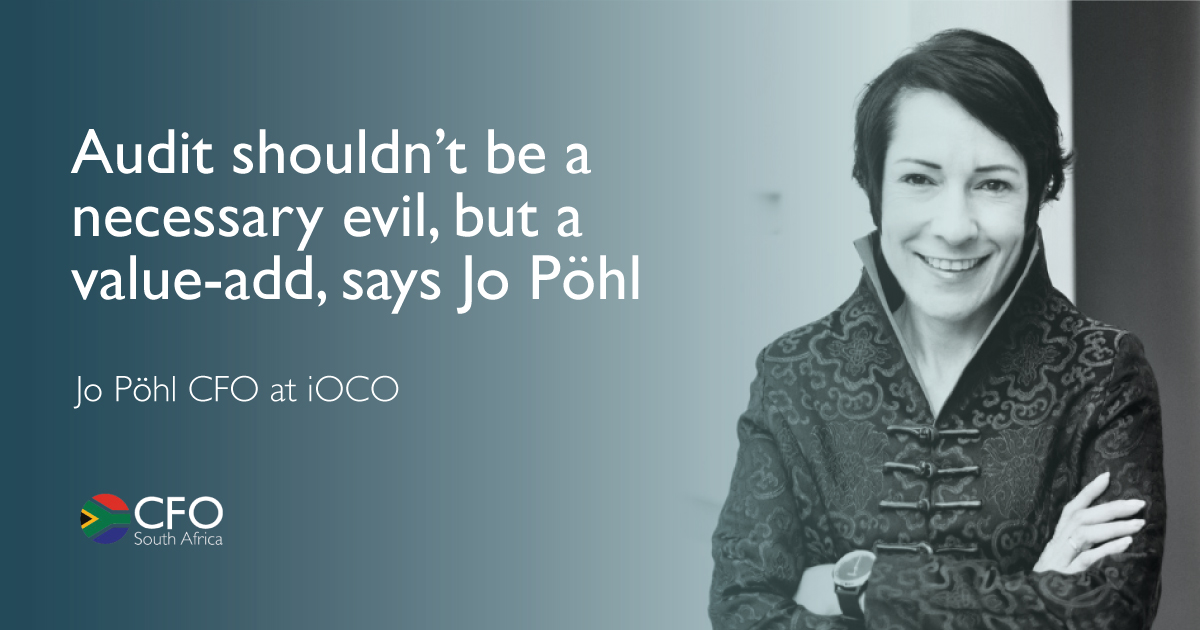Audit has moved from being “an event” to an ongoing partnership between the business and its assurance providers, says Jo Pöhl, CFO at iOCO (a wholly-owned subsidiary of EOH). “Ideally, we should always be audit-ready, with a continued focus on enhancing financial discipline and sound governance, whether it’s internal or external audit,” she says.
iOCO is the core ICT business of the EOH group, which is in the middle of completing its second year of virtual audits. “The group had appointed new auditors at the time of the first virtual audit, which added to the complexity of the process but enabled us to learn a lot,” says Jo. “This has enhanced our efficiencies for this financial year.”
Jo is a qualified chartered accountant (CA(SA)) and FCCA and professional banker of the Institute of Bankers in SA (PBSA). She believes that digital transformation is enabling greater value-add by streamlining the audit process and enabling reviews and quality assurance that extend well beyond sample testing.
Covid-19 has accelerated this. “The reality is that audit shouldn’t be about whether there’s a little black book with any bad tick marks against your name, but rather validating what we believe we’ve done in terms of an effective and enhanced control framework, delivering on our mandate as finance, as well as our fiduciary duties as directors and managers. Audit shouldn’t be a necessary evil, it should be a value-add,” says Jo.
“I think Covid-19 allowed us to completely rewire how we think, thereby influencing how we operate. When you have a crisis that forces increased levels of transformation and digitisation, what you thought would take months – maybe even years – is suddenly expedited and possible. We’ve become better at learning, unlearning and relearning, which has enhanced our understanding around what is being tested and why, and the alternative methods that could provide sufficient assurance. We were already working with computer aided audit testing programs and now completeness testing takes this to a new level.”
However, what was theoretical suddenly became practical and Jo says iOCO had to unpack what a virtual audit entailed in terms of people engagement, how to file audit evidence and solve for issues like electronic sign-off. “How we interact, how assurance is gained or how audit evidence gathered has changed, and I don’t think we will go back,” she says.
She says the virtual audit process has driven a re-evaluation of what can be done more efficiently and effectively, from detailed planning to early testing, and real-time walk-throughs to test key processes or controls.
Planning and communication are paramount
Jo emphasises that audit is a partnership. She notes that establishing relationships is trickier virtually than face-to-face and so, in the second round of the virtual audit, the finance team was deliberate about getting around the table with the external audit team before kicking off. They’ve also been intentional in communicating in-office days and hours and setting up regular check-ins across all component audit teams within the group, which comprises multiple entities.
“Planning upfront is critical: the combined planning between client and audit firm, and the various teams themselves. We identified “stream leads” upfront from the finance team and for the external auditors. Where you’re trying to connect dots across multiple streams, having a single team lead has helped us be much more aligned and efficient,” says Jo.
The process has also prompted the re-evaluation of information security and version control measures. Jo believes that they will begin to see the full value of virtual audit from year three, based on the efficiencies, lessons learned and groundwork laid.
Jobs yet to be created
Jo says there’s a pervasive belief that as the finance function moves towards greater automation, jobs will be lost. But there is little focus on the jobs yet to be created. Automating routine tasks allows finance professionals to “step off the hamster wheel”, reflect more and spend time adding value by asking questions and gleaning insights from the data versus reporting on the past.
“We can ask ‘why, what if, or does it make sense?’ For example, if we leverage the automation of routine tasks, then our review and assessment processes allow us to move from reconciling to substantiation, and from reporting to insights. This changes the framework of what it is we look at and focus on as finance,” she says.
“We can run better scenarios around business planning, capital allocation, going concern and liquidity assessments, which are all key to closing out on the audit. This also impacts our capacity positively as finance partners, so that we can crunch the right numbers, validate our assumptions given the dynamic environment we are in and extrapolate a medium-term view with options of what the trajectory of our business could look like. That helps us manage our business more proactively as opposed to reactively. Agility has been particularly key under Covid-19.”
She says that automation allows for the better use of human capacity and capability. “Your greatest ideas generally come when you have enough time to really think.”
She adds that innovation does not have to be “the next big thing” like Uber or Amazon, but encompasses anything that improves user experience (UX). “It’s about being stakeholder-centric and in our case, stakeholders include regulators, shareholders, revenue authorities, banking partners, suppliers and clients. Auditors form part of this stakeholder group too, with audited financial statements still required as part of supplier onboarding processes, bid tenders and ensuring tax compliance.”
In conclusion, Jo believes that audit is an invaluable assurance function that will continually evolve as the profession continues to embrace and integrate digital automation.



